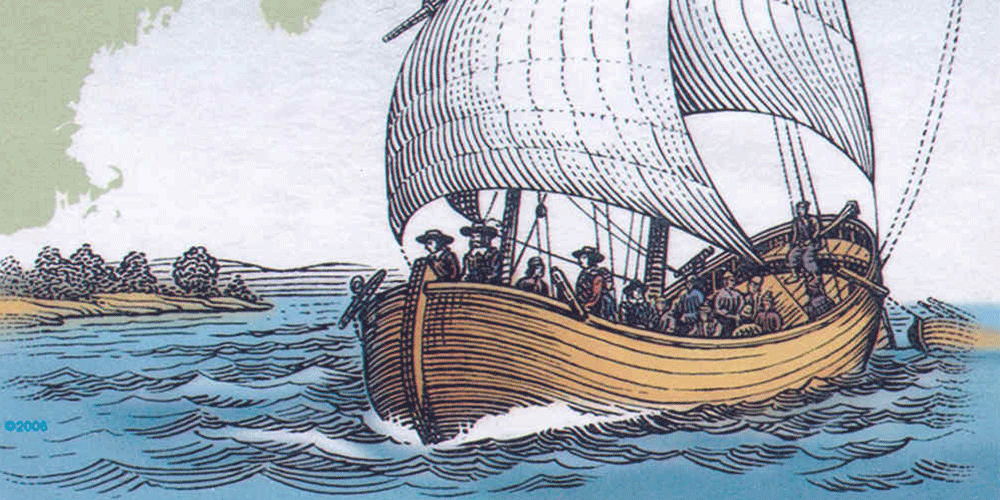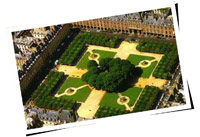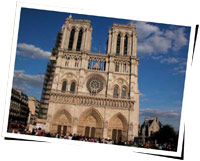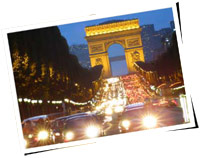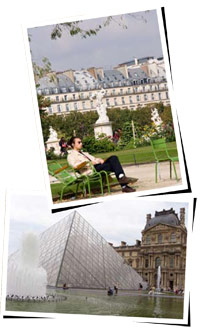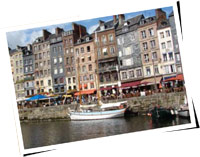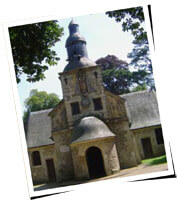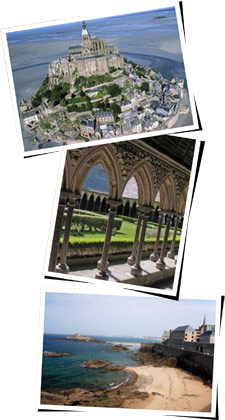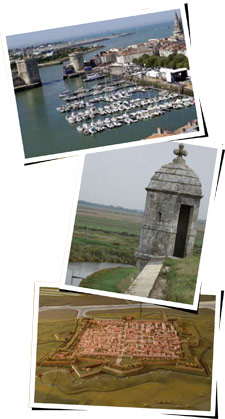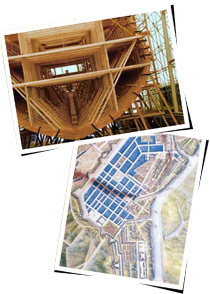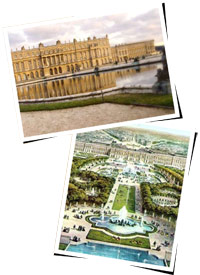Featured image: Stamp with drawing of Samuel de Champlain’s ship
For those who were curious to know more about the tour I mentioned in the article On the Steps of Champlain – Part 1, here are the details of the 7-day tour across France, on the steps of Samuel de Champlain. It was an extraordinary trip. If you ever have a group interested in doing this tour, don’t hesitate to let me know.
Day 1 – Discovering the Paris Samuel de Champlain knew, the “quartier” (sector) where he lived.
Place des Vosges
In 1605, King Henri IV decided to turn the Marais district into Paris’ most exclusive residential area. Flanked by the Pavillon du Roi (King’s pavilion) and the Pavillon de la Reine (Queen’s pavilion), the area was named Place Royale. His son, Louis XIII completed the project. None of the royal family ever actually lived there.
The remainder of the square is configured with 36 symmetrical houses each with a ground-floor arcade, steep slate roof, large dormer windows, and vine-covered walls. The first of the houses were built of brick, the rest were built rapidly and given timber frames and faced with plaster. The plaster was later painted to resemble brick.
Duels, fought with strictly observed formality, were once staged in the elegant park in the middle which contains a statue of Louis XIII. From 1832 to 1848 Victor Hugo lived at a house at No 6, which has now been turned into a museum. Cardinal Richelieu lived at No. 21. In 1800, the square was renamed Place des Vosges. Today, the arcades at street level are occupied by expensive galleries, shops, and cafes.
Notre-Dame de Paris
The twin towers and three sculpted portals of the Notre-Dame de Paris, built from the 12th to the 14th century, are instantly recognizable… The towers are 69 meters high while the spire, a 19th-century addition, soars to a height of 90 meters. Immortalized in Victor Hugo’s novel The Hunchback of Notre Dame, the cathedral is a Gothic masterpiece enhanced by delicate stone filigree work.
Some of the fine stained-glass windows date back to the Middle Ages. Importantly, one must not forget to look up at the ghoulish gargoyles that adorn the roof gutters of the building.
Day 2 – More of Paris
Arc de Triomphe and the Champs Élysées
Commissioned by Napoleon in 1806 in homage to French military victories, the arch was completed 30 years later during the reign of Louis Philippe, the last King of France, who dedicated the monument to the glory of the revolutionary army and the French army in general.
It is adorned with reliefs and sculptures depicting scenes from Napoleon’s epic battles. Twelve avenues stem from the monument, most of which bear the name of a famous battle fought by Napoleon, such as Friedland and Wagram. Paris is literally at your feet as you look out, on the one side, the Champs-Elysées, the Place de la Concorde, the Jardin des Tuileries, and the Louvre and, on the other, the Arche de la Défense.
Jardin des Tuileries – Garden
This was the first public garden in Paris. This 280,000 square meters green setting between Place de la Concorde and rue de Rivoli was designed by André le Nôtre in 1664. The French flower beds, clumps of trees, outdoor scluptures and little ponds are flanked by the Musée du Jeu de Paume and the Musée de l’Orangerie. A great place for an outdoor lunch at a busy café.
Le Louvre Museum
The Louvre, in its successive architectural metamorphoses, has dominated central Paris since the late 12th century. Built on the city’s western edge, the original structure was gradually engulfed as the city grew.
The dark fortress of the early days was transformed into the modernized dwelling of François I and, later, the sumptuous palace of the Sun King, Louis XIV. The Louvre is one of the French capital’s most renowned sites.
With its rich past and collections, it is one of the world’s greatest museums. The best known of the Louvre’s extensive art collection is undoubtedly the most often-visited and famous painting, Leonardo da Vinci’s Mona Lisa, located in the Renaissance Italian Paintings section.
The Winged Victory of Samothrace, the celebrated headless statue with outspread wings, and the Venus de Milo are two of the most frequently viewed Greek statues, while the Seated Scribe is one of the most emblematic pieces in the Egyptian Antiquities section.
Day 3 – Honfleur, Normandy – the harbor from where Samuel de Champlain launched his expeditions to New France
Honfleur Harbor
Honfleur is a town surrounding a beautiful little 17th-century harbor in Normandy. Honfleur is especially known for its old, beautiful picturesque port, characterized by its houses with slate-covered frontages, painted many times by artists.
Still active as a fishing port, and now a popular yacht harbor, the town has preserved its rich historic and artistic heritage with its picturesque streets, traditional buildings, museums, churches, and monuments.
The oldest, and most visited, part of Honfleur lies within the area of the Hôtel de Ville (City Hall), the deconsecrated church of Saint-Etienne, the remains of the old prison and the original 17th century Salt Halls (Greniers à Sel), now used for exhibitions and concerts. Sainte-Catherine’s 15th- and 16th-century church was built by local shipbuilders as a temporary structure and is the largest wooden church with a separate bell-tower in France.
Its ceiling resembles the hulls of upside-down ships. Built entirely of wood, even including wooden roof shingles, the church has a very peaceful, intimate atmosphere. The bell tower, also largely built of wood, dates from the end of the 15th century.
Notre-Dame de Grâce Chapel
The Notre Dame de Grâce Chapel is one of the region’s oldest sanctuary chapels. It’s a charming little chapel adorned with model wooden boats of every kind.
You can also see plaques telling the tales of New France’s explorers who left from Honfleur, including, of course, Samuel de Champlain. The chapel was founded by Richard II and rebuilt between 1600 and 1615. It offers beautiful views on Honfleur and on the Seine. A quiet place for the perfect picnic on the lawn.
Day 4 – The Brittany Coast
Mont Saint-Michel
At the border between Normandy and Brittany, the Mont Saint-Michel and its abbey are one of the first sites to obtain UNESCO World Heritage listing. Of medieval architecture and constructed on a granite pinnacle, the Abbey of Mont-Saint-Michel is an exceptional viewpoint to the entire bay, where the tides are the strongest in Europe.
According to legend, the monastery was founded after the appearance of the archangel Saint Michael, and grew from the 10th to the 15th century on several floors around the abbey church.
All the rooms related to monastic life are stacked above one another around the top of the rock and are evocative of one of Christianity’s most important pilgrimage places.
And at the foot of the abbey stands the village with its fortified enclosure – built on sand! The heroic resistance of the Mount to English attacks during the Hundred Years’ War (14th and 15th centuries) made it a symbol of the French national identity. Monks left the abbey in 1790, and it was later listed as a historic monument and returned to its former glory thanks to constant restoration work.
Saint-Malo and its Fort National
Walled and built with the same grey granite stone as Mont Saint-Michel, Saint-Malo was originally a fortified island in the Middle Ages. Later, it became notorious as the home of fierce pirate mariners, who were never quite under anybody’s control but their own.
The corsaires of Saint-Malo forced English ships passing up the Channel to pay tribute, and brought wealth from further afield. Jacques Cartier, who colonized Canada, lived in and sailed from Saint-Malo, as did the first colonists to settle the Falklands, hence the islands’ French name, les Malouines.
Saint-Malo is now attached to the mainland. From outside the walls, the old city looks impressive, and within the walls, you’ll find charming narrow streets and a lively town. Former Fort Royal, Fort National was built in 1689 according to plans by Vauban and on the orders of King Louis XIV, along the ramparts of Saint-Malo, as an advanced bastion to defend the city. Lots of history in this walled old city, but also the best place to try the traditional Brittany crepes!
Day 5 – La Rochelle and Brouage, Poitou Charentes – The birth place of Samuel de Champlain
La Rochelle
La Rochelle was founded in the 10th century as a fishing village which began to expand in the 12th century to reach its apogee in the following century through the wine and salt trade. In the 18th century, sea trade especially the regular interchange with New France and the West Indies kept the city prosperous.
Anchored to the Atlantic coast, near the Islands of Ré and Oléron, La Rochelle is now well known for its various ports: the Old Port in the city centre, the marina at les Minimes, the Commercial port of La Pallice, and the fishing port of Chef de Baie.
La Rochelle also has a rich architectural heritage, with its two Towers guarding the Old Port and hosting interesting exhibits; but also its churches, its secret roads lined with arcades, its old wooden and aristocratic houses, and its stately residences.
Brouage
Brouage was founded in 1555 on the Bay of Biscay facing the Atlantic Ocean. Its economy was based on salt and access to the sea. The town was fortified between 1630 and 1640 according to plans by Vauban and on the orders of Cardinal Richelieu as a Catholic bastion in order to fight against the sieged Protestant town of La Rochelle.
After 10 years of construction, the town could maintain a 6000-men garnison and became the best-fortified town on the Atlantic Coast. Its fortifications are of a square shape with sides of 500 meters long and 7 towers.
It’s in Brouage that Samuel de Champlain was born between 1567 and 1570, in a Protestant family. However, at the end of the 17th century, the founding of Rochefort and the re-establishment of La Rochelle deprived Brouage of its military importance.
Gradually the harbor silted up leaving the town stranded and useless as a port. It fell into ruin. It has found a new life today and it is a simple village with its white houses and paved streets.
Day 6 – Rochefort and its 17th century naval arsenal
Hermione – Lafayette’s Frigate
In Rochefort’s old naval arsenal, visitors have the privilege to see the rebuilding of the Hermione. The Hermione was a 12-pounder frigate of the French Navy. She took General Lafayette to the United States in 1780 to allow him to join Americans in the American Revolutionary War.
She was one of a series of four similar frigates built in Rochefort. Her rebuilding started in 1997 and is expected to take 10 years, while the original one was built in less than one year, but with many more workers than today.
Corderie Royale
On the shores of the Charente River, stands the Corderie Royale, the 17th century Royal Rope Making Factory, built by Colbert at the request of Louis XIV. In 1662, the glorious Sun King asks Jean-Baptiste Colbert to build a maritime arsenal on the Atlantic Coast, “worthy of his Majesty, his reign and of the greatness of his royal armies”.
After 4 years of searching for the ideal location, Colbert chooses Rochefort as its site and builds “the biggest, most beautiful [arsenal] there is in the world”. The Royal Rope Making Factory was a brilliant expression of Louis XIV’s greatness and a pre-industrial, architectural masterpiece. It fabricated the ropes which were required by the sail warships of France.
Day 7 – Versailles and the end of the trip
Château de Versailles
The Château de Versailles is one of the most beautiful achievements of 18th-century French art. It was Louis XIV who chose the site to build the palace we know today, the symbol of royal absolutism and embodiment of classical French art.
Louis XIV moved the court and government of France to the Château de Versailles in 1682 and it remained the seat of power until 1789. The grounds, known generally as le parc were designed by André Le Nôtre who “raise[d] the art of garden-craft to a height it has never attained since, and of course had never been reached previously.”
Although the inspiration for the gardens came from the Italian renaissance, the gardens of Versailles are in a league all their own.
Interestingly, the Château de Versailles emerged from very humble beginnings. The word versailles itself comes is of uncertain origin but seems to be from the Latin versare meaning “to keep turning over” and was used in medieval times in the agricultural context of plowed land.
It bears a resemblance to the French semailles which means “sown seeds”. This etymology is interesting because Versailles is associated with splendor and absolute power, and yet its very name brings it back to its original state of being a neglected piece of land. Louis XIII had a small hunting lodge on the site, but it was Louis XIV who began to restructure the location into an icon of absolute power and timeless domination.
Interested in such an adventure? Have I tempted you?
If you are a group interested in such a tour, don’t hesitate to contact me. I’ll be more than happy to organize such a trip for you and/or be your guide.

